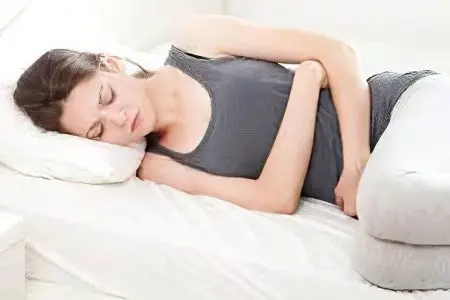
Pain, which is noted by a person in the lower abdomen and in the lower back, can be caused by both acute and chronic diseases. These unpleasant, and sometimes unbearable sensations, can be of a different nature. The acute form of the disease (bleeding, perforation, organ rupture), as a rule, proceeds with very strong and sharp pains. Dull, pulling or constantly aching pain is more often observed in chronic inflammation. Throbbing pain may be a sign of increased intracavitary pressure. An accurate diagnosis can only be made by a qualified specialist after a medical examination and diagnostics.
Painful sensations simultaneously in the lower abdomen and back can be symptoms of the following diseases:
Appendicitis. Inflammation of the appendix is often accompanied by chills, nausea, and vomiting. Pain in appendicitis can radiate to any area of the abdominal cavity, as well as to the lower back. Pain sensations are not only acute, but also dull, aching.
Infections of the urinary system. These include cystitis, pyelonephritis, urethritis. The causative agents of diseases are mycoplasmas, ureoplasmas, chlamydia, gonococci, Klebsiella. With inflammation of the bladder, there is an increase in the frequency of urination. These diseases can be characterized not only by pain, but also by the presence of blood in the urine.
Intestinal infections. In the early stages of the disease, dull non-localized pain captures the entire abdomen. Further, it concentrates in the lower abdomen and gives to the lumbar back. Mucous and bloody inclusions may be noted in the feces. Salmonella is often the causative agent of this bacterial infection. Medical care in case of this disease is urgently needed, since sepsis is possible with a belated visit to the doctor.
Colitis. Associated symptoms include fever and flatulence. The disease begins with an acute phase and after a few days can become chronic. The sharp pain is replaced by a dull one.
Inguinal hernia. A protrusion under the skin and pinching by the muscles of the internal organ (or part of it) causes very sharp pain up to fainting. There may be nausea, vomiting. A person with this disease needs urgent medical attention.
Urolithiasis disease. The pain can be intermittent and dull, or it can be constant and very sharp (when the stone moves). Its localization is often noted in different parts of the abdomen and lower back.
Osteochondrosis. Destructive changes in the lumbar vertebrae cause pinching of the nerve roots, thereby causing a violation of the innervation of the organs. The main pain is localized from the back, but it can radiate to the groin and legs.
Malignant tumors. The variants of pain under consideration may turn out to be symptoms of cancer of the genitourinary and digestive systems.
Causes of pain in women:

Premenstrual illness. The pain is caused by spasmodic contractions of the uterus. More often they happen on the eve or in the first days of menstruation. Often, pain is provoked by a chronic inflammatory or adhesive process. An unfavorable background is the unstable work of the hormonal system.
Death of the uterus. It is formed as a result of adhesive processes after inflammatory diseases or is an innate feature. At the same time, the lower abdomen pulls and a slight lumbar pain is felt.
Myoma. This benign growth may not cause pain. But in some cases, with a large size and a certain localization of the neoplasm, cramping pain can be observed.
Adnexitis (salpingoophoritis). Various pathogens (staphylococci, gonococci, streptococci, Koch’s bacillus) can cause an inflammatory process in the ovaries or fallopian tubes. The disease can begin after an abortion, childbirth or sexual contact during menstruation. Chronic adnexitis can worsen due to hypothermia and weakened immunity.
Endometriosis. The inflammatory process in the cavity of the uterus and ovaries is characterized by constant, intensifying pain during menstruation.
Torsion of the peduncle of the cyst. When the cyst turns, the venous and arterial vessels that supply the cyst are compressed, after which the necrosis of this formation begins. Pathology is accompanied by increasing pain after physical activity or sex, as well as fever, nausea and vomiting.
Ectopic pregnancy. From the moment the fetal egg attaches to the inner lining of the fallopian tube, pulling pains in the abdomen begin, radiating to the lower back. Pathology may be accompanied by bleeding of varying intensity. Often women lose consciousness. This complication requires prompt medical attention, as rupture of the fallopian tube is very likely.
Rupture of an ovary or oviduct. The pain is intense and unbearable. There may be fainting. Surgical care for such a diagnosis is necessary on an emergency basis, since infection of the abdominal cavity is possible.
Risk of miscarriage. As a result of physical exertion, various infections or pregnancy pathologies, uterine hypertonicity or placental abruption may occur. In this case, pain in the abdomen prevails over that in the lower back. These symptoms are quite serious, especially if they are accompanied by spotting. A pregnant woman needs immediate medical attention.
Causes of pain in men:
Prostatitis. In men, inflammation of the prostate can be the cause of painful symptoms in the lower abdomen and back. This disease is also accompanied by a feeling of pain during urination and defecation.
Orchoepididymitis. Inflammation of the testicles and their appendages can be caused by chlamydia, gonococci, enterobacteria. Another reason that causes this disease is injuries, including postoperative ones. Parallel symptoms are fever and chills, nausea and headache.









